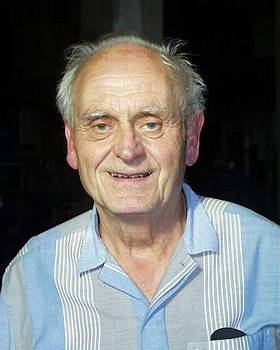|

Engaging and colourful
Bernard Roberts plays music by Stephen Dodgson,
reviewed by MALCOLM MILLER
The engaging and colourful Piano Sonata No 7 by Stephen Dodgson, who celebrated his eightieth birthday earlier this year, received its London première and second performance at an inspiring recital by the distinguished pianist Bernard Roberts. Dodgson's new work, with its great sense of improvisatory fantasy and lyricism, was ideally programmed between Beethoven's two Op 27 sonatas and the Schubert B flat sonata D 960. The concert took place on Sunday 14 November 2004 before a capacity audience at the Church of the Christian Community, Glenilla Road, London NW3, the main concert presented this year by the Glenilla Arts Society, of which Bernard Roberts is President and a frequent performer, to the delight of the mainly local audience members. As Dodgson himself explained, the new sonata was commissioned by the Basingstoke Concert Club of which Bernard Roberts is also President, and for whom he gave the world première on the previous evening, as part of its fiftieth season.

Stephen Dodgson in 2001. Photo: Keith Bramich
|
There is a long standing performer-composer relationship between Bernard Roberts and Stephen Dodgson: Roberts had recorded all six of Dodgson's solo sonatas and his most recent release is a CD of the three piano trios and recent set of piano Bagatelles (Claudio Records). In all Dodgson's works, including those for guitar and harpsichord for which he is well known, there is a strong sense of logical conceit, of structural balance and argument leading to some sort of resolution. Yet in this seventh sonata there are signs of greater simplicity and lyrical poetry, its harmonic language following his earlier tonal centred chromaticism, more lucid here than ever in its allusions to Prokofiev and Copland. All three movements of approximately equal duration are flowing, expressive and full of idiomatic pianistic gestures and an individual harmonic and textural syntax within a broadly neo-classical frame. The first movement is introduced by a short slow preamble to set the harmonic mood, a mixture of dissonant bite and widely spaced enriched consonant chords. The rising scalic first subject, treated in counterpoint, is contrasted by a jaunty, rhythmic second subject, and after their development, the recapitulation leads to a climax in the highest registers. The slow movement with its barcarolle-like rhythm, has a pastoral quality, trilling gestures accompanied by sliding drone-like bass, the airy textures giving way to a stronger chordal theme which builds to a climax before resuming the earlier calm. The last movement articulates a confrontation of two themes in contrasting metres, resolved by the eventual appearance of a third theme, and leading to a strong conclusion. It is a work that requires an interpreter of the depth and understanding of Bernard Robert, whose precise and lucid touch projected the harmony and thematic process with resonant colours and bite.
Continue >>
Copyright © 16 November 2004
Malcolm Miller, London UK

|

